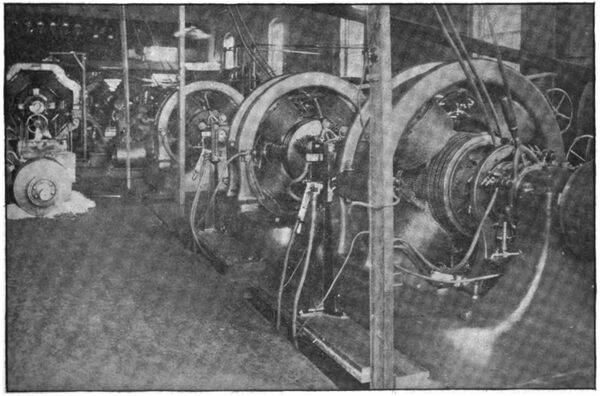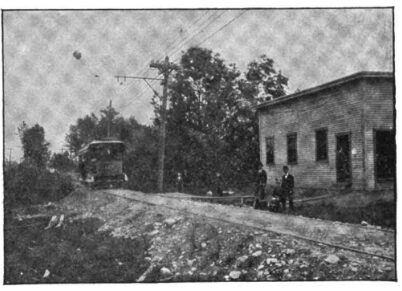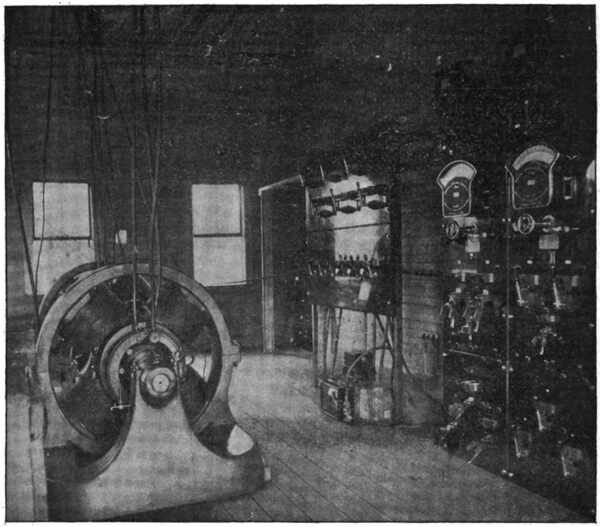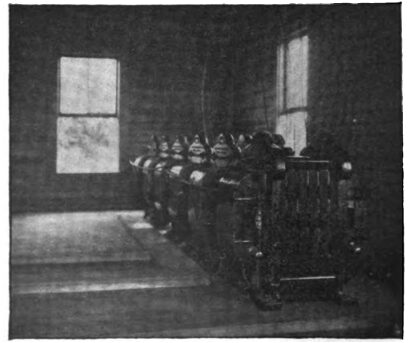[Trade Journal]
Publication: The Electrical Engineer
New York, NY, United States
vol. 20, no. 389, p. 375-377, col. 1-2
THE THREE-PHASE RAILWAY SYSTEM AT
LOWELL. MASS.
The first adaptation of the three-phase system to the operation of the electric railway was that carried out by the General Electric Company on the Norwich, Conn., road. In this instance three-phase current generated at Baltic is brought over a distance of four and one-half miles, to Taftville, where, in the basement of the Ponemah Mills, it drives a synchronous motor, which in turn not only operates all the machinery in those extensive mills, but, through countershafting, drives several direct current generators furnishing current for the operation of the Norwich Street Railway, as well as for that of a forty-ton electric locomotive used as a switching engine in and around the Taftville Mills.
For the next instance the continent must be traversed to Sacramento, Cal., where current is brought at 11,000 volts from the water driven generator station at Folsom, twenty-four miles away. This is transformed at a sub-station and led to motors belted to the direct current generators which supply the ordinary 500-volt current to the motors on the Sacramento street cars. This plant is now in daily operation and no difficulty has been encountered since the start.
In both these instances, it will be seen that the three-phase current is used to drive motors which in turn drive direct current railway dynamos of the usual pattern. At Lowell, Mass., however, the General Electric Company has recently adopted an entirely different method, which dispenses with the second step, i. e., the employment of the motor driven direct current generator. Its place is taken by a machine, which is, in reality, a motor and a generator in one.
The company to which falls the honor of first using the three-phase system directly in its railway service is the Lowell and Suburban Railway, which, under the guidance of Mr. P. F. Sullivan, a man of energetic and progressive stamp, is now taking a step which should indubitably add largely to its revenues. The problem before the Company was, how best to connect its terminus at Lakeview, a delightful resort on the Lake, owned by the Company, with the car line leading to Nashua, fifteen miles away. The solution was found in the uae of the three-phase system, but not before careful examination had been made of its merits, from the points of view of economy, efficiency and durability and comparison with other systems.
| |||
| Three-Phase Generating Plant, Lowell and Suburban Electric Railway System. |
Briefly, the principle of the installation is this: The three phase current generated at Lowell, is, at a pressure of 5,600 volts transmitted, part to a point about midway between Nashua and Lowell, and part to a substation at Nashua itself. It undergoes at both these points, first a reduction of pressure in static transformers, and then a conversion from the three-phase current in a rotary converter, emerging upon the feeder and trolley lines a direct current of 500 volts.
The three-phase generating plant is located in the power house of the Lowell and Suburban system, situated on Middlesex street. It consists of three, four pole 120 K. W. 900 revolutions, three-phase generators, each of which is constructed to deliver alternating current at one side and direct current at the other. The direct current is called into action only after the main power plant, consisting of six General Electric M. P. 200 K. W. belt driven railway generators, is shut down.
| |||
| Substation for Converting Three-Phase to 500 Volt Direct Current. |
The three-phase generators are compact machines, and are connected by belts to a jack shaft which runs the entire length of the engine room close to the west wall. This shafting has been arranged to permit of any combination of engines and generators the combinations being made by means of clutches. The generators are rated at 216 amperes. The three-phase current issues at a pressure of 360 volts and is carried to the switchboard, from which it passes to a bank of transformers, erected on a platform, placed in the cellar of the station and set between two of the engine foundations. These transformers are of the General Electric air blast type. They are cooled by a blast of air driven through them by a rotary blower belted to a 1 H. P. motor.
From the transformers the three-phase current issues at a pressure of 5,000 volts, and is carried over insulated cables to a short distance outside the city limits, where it passes to the ordinary three-phase wires which run along the highway upon the same poles that carry the direct current feeders. The three-phase wires are carried upon heavy, wide, petticoated glass insulators, set upon the side of the cross arm near the road; while the direct current feeder cables occupy that part of the cross arm on the other side of the pole.
About six miles from Lowell, and a mile and a half from Lakeview, at a place called Eayr's Mills, upon the banks of the Merrimac River, the first substation has been erected. This is a wooden structure divided by a partition into two rooms, the outer, or that nearer the line, being occupied by the rotary converters and direct current switchboards; the inner containing the bank of reducing transformers, also cooled by air blast, and the threephase switchboard.
The three phase current is brought into this building from the pole over cables, to the transformers just mentioned. In these the pressure in reduced from 5,500 volts down to the original pressure of 360 volts. The current then passes into the outer room to the two rotary converters; it issues therefrom, railway direct current of 500 volts pressure, and is carried to the direct current feeders and trolley wires.
| |||
| Three-Phase Rotary Transformer and Switchboard in Substation. |
These rotary converters are similar in appearance to the three-phase generators, having at one side collector rings at which the three phase current is received, while at the other is a regular commutator from which the direct current is taken.
From the two converters the 500 volt current is carried to the feeders and is fed into the trolley wires, towards Lakeview and Lowell in one direction and towards Nashau in the other through a regular railway switchboard of panel construction. The substation at Nashau is identical with that at Eayr's Mills. It contains two rotary converters, feeding part of the current into the main railway line from the Nashua end, and part into the City lines. The operation of the rotary converters has proved entirely satisfactory. The machines have been subjected to heavy overloads, sometimes running as high as 50 per cent, more than the rated capacity, without any detriment.
| |||
| Static Transformers in Substation. |
The cars running between Lakeview and Nashau, are of special make and hold a place about midway between the steam railroad car and the regular street car. They are fitted with sixteen benches, and are mounted upon two independent trucks. They are equipped each with two G. E. 800 motors, controlled by "K2" controllers. The speed attained on the open highway between Lakeview and Nashau, reaches as high as thirty miles an hour without difficulty.
The traffic between the two last mentioned points is already very large and the line has brought the inhabitants of the two busy New England manufacturing cities into closer connection than ever. It enables also the inhabitants of the little hamlets scattered between to come to either for a moderate fare, which is only ten cents for the entire distance, or five cents from either to Lakeview.
The carriage of freight, by special freight cars has, we believe, not yet been contemplated, but now that the facilities exist this service will probably be started later on.
It is expected that the success which has attended this installation, will be the precursor of a new era in travel; already numerous inquiries have come in regarding the possibility of the adaptation of the system to transit between towns holding a relation similar to that between Lowell and Nashua.




